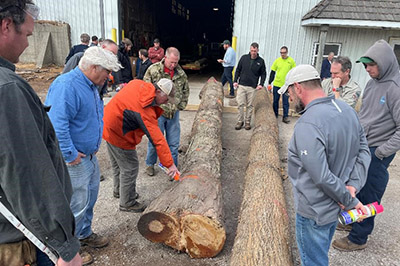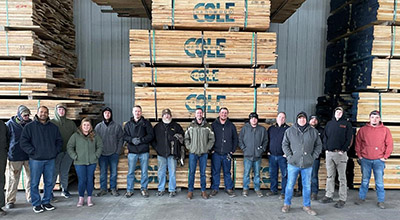Hardwood University Offers Cutting-Edge Information, Training to Industry Professionals
The 2024-25 edition of Hardwood University’s industry curriculum is available now with the first course set to take place on Sept. 24 at Martell Forest.
take place on Sept. 24 at Martell Forest.
In 2020, Dr. Rado Gazo created Hardwood University, a self-sustaining collaborative program with the Indiana Hardwood Lumbermen’s Association, which aims to provide hardwood industry professionals and landowners in the Central Hardwood region with cutting-edge information and training. Gazo also is one of the primary instructors for the program.
“Nearly 200 hardwood industry professionals participate in Hardwood University annually,” Gazo said. “Workshops take place at Indiana’s premier hardwood mills and forests, giving in-state and out-of-state participants an opportunity to understand the hardwood industry from selecting trees for harvest to manufacturing finished products.”
Hardwood University, which consists of multiple sessions annually covering various aspects of the field, is intended for new employees in the hardwood industry as well as those preparing for advancement or cross-training. The program, which takes place monthly at various Indiana hardwood plants and Purdue Agriculture Centers, offers informational and technical sessions on topics ranging from forest taxation to tree and log scaling and grading; log bucking; marketing hardwood veneer, stave and sawlogs; grade-sawing lumber; air drying and kiln drying lumber; hardwood lumber grading; lean manufacturing and logistics; and sawmill efficiency and quality control.
Registration is required and is available online.
Each individual class costs $79 per person. Individuals also can sign up with the Hardwood University One-Pay option for $999, which allows a company to send up to four employees to any class, all for one annual fee. Credit card payments will be charged a 3% processing fee.
The session breakdown for the 2024-25 curriculum is below as well as online.
Sept. 24 – Name that Tree and ID that Wood, taught by Purdue Extension forester Lenny Farlee and Dr. Eva Haviarova at Martell Forest; West Lafayette, Indiana
Hands-on experience in identifying local hardwood species of trees when looking at bark, leaves, and twigs. Practice distinguishing and identifying wood from these trees. Learn about the importance of Midwest hardwoods as a fascinating carbon-sequestering material
Oct. 16 – Marketing Hardwood Veneer, Stave, Sawlogs – taught by Mark Thesin and Dr. Rado Gazo at Danzer Veneer; Edinburgh, Indiana
Discuss tree quality and log merchandising. The highest-value use of our hardwood resource is for fine face veneers. Excellent markets have always existed for “perfect” trees and logs. Marketing of “somewhat less than perfect” trees and logs can present a challenge. The practicing forester may be unsure what a particular veneer buyer can accept and why the log or tree value varies widely and changes weekly. Furthermore, the markets for the veneer itself change. A tour of the Danzer facility and showroom are included
Oct. 23 – Urban Forestry – taught by Purdue extension urban forestry specialist Ben McCallister and Purdue Extension educator in Monroe County, Ed Oehlman in Washington, Indiana.
Introduction to Urban Forestry and Arboricultural Practices. Learn about tree physiology and tree species identification and characteristics. Introduce the basics of disease and pest diagnostics. Learn about proper pruning practices and tree planting including site characteristics, choosing a tree, and post-care after planting
Nov. 13 – Grade-sawing Hardwood Logs – taught by Dr. Rado Gazo at Pike Lumber Company in Akron, Indiana.
Theory and practice of sawing hardwood logs into lumber. Observe external characteristics affecting lumber quality and measurement of selected logs. Discuss decisions made at head saw, resaw, edger, and trimmer that affect the lumber grade. Cut logs on a portable sawmill to observe the process in practice and evaluate the impact of right/wrong decisions
Nov. 20 – Digital Forestry Part 1, Recent Advances – taught by unmanned aerial systems data collection specialist Cameron Wingren at Martell Forest; West Lafayette, Indiana
Discuss new and emerging technologies that the Institute for Digital Forestry is using to advance the field of forestry into the digital age. A smartphone app for automated tree measurement, drone operations and considerations, and a free web-based platform for sharing digital data will be discussed
Jan. 29, 2025 – Selling Kiln Dried Hardwoods – Dynamics for Buying, Selling and Managing Inventory, taught by the Banks Hardwoods staff at Banks Hardwoods; White Pigeon, Michigan
Discuss supply chain dynamics and kiln-dried hardwood lumber selling principles and responsibilities. This course is designed for buyers looking to increase supply chain knowledge, Production managers who deal with raw input variabilities, and sales team members who seek skills to improve customer service and value. Topics will include questions to be addressed at each stage in the buy/sell process, what to look for when visiting an account, lessons learned from missed opportunities in the field, and facing objections. This is an interactive experience with lectures, examples, a plant tour, audio/visual, and extensive Q&A. Max attendance: 25 for this event
Feb. 12, 2025 – Air Drying Hardwood Lumber, taught by Dr. Rado Gazo at Cole Hardwoods; Logansport, Indiana
Indiana
Discuss the moisture content of wood, why drying is necessary, and various ways in which to dry lumber. Review principles of setting up a quality air-drying yard, proper lumber stacking, and basics of wood preservation
March 5, 2025 – Kiln Drying Hardwood Lumber, taught by Dr. Rado Gazo at Macbeath Hardwood; Edinburgh, Indiana
Discuss various methods and types of dry kilns, and their pros and cons. Learn to develop a kiln-drying schedule and a way to select and check kiln samples. Discuss lumber drying defects and how to prevent them
April 2, 2025 – Tree Bucking, taught by Dr. Rado Gazo and Purdue forester Don Carlson at Schwering Sawmill and Hardwoods; Greensburg, Indiana
The value of lumber, veneer, and other wood products that come from a given tree can be significantly increased when that tree is cut to optimal log lengths. Factors that influence bucking decisions, along with the economic impacts of correct and wrong bucking choices will be discussed
April 16, 2025 – Digital Forestry Part 2 – Drone Operations, taught by Cameron Wingren at Martell Forest; West Lafayette, Indiana
Discussion and hands-on experience with using drones for forestry. The Institute for Digital Forestry will highlight how drones can be a useful tool for monitoring and measuring forests. Additional demonstration and hands-on experience with a free web-based platform for storing, sharing, and viewing drone imagery will be included
April 30, 2025 – Introduction to Hardwood Lumber Quality/Grading, taught by Dr. Rado Gazo at Martell Forest; West Lafayette, Indiana
Basic overview of reasons for grading lumber, measurement of boards, and NHLA lumber grading rules. Limited practice of grading sample boards. Discuss how log quality affects lumber grade and how head sawyer, resaw, edger, and trimmer operators can maximize value potential
May 7, 2025 – Tree and Log Quality, Scaling and Measurement, taught by Dr. Rado Gazo and Don Carlson at Southeast Purdue Agricultural Center; Butlerville, Indiana
Observe standing trees and discuss tree grades. Practice tree scaling and grading on selected trees. Fell a tree and discuss bucking decisions to maximize the value of each log. Discuss and practice log grading
 A collage of images from Hardwood University courses. Top row (Left to Right): Grade-Sawing Hardwood Logs; Marketing Hardwood Veneer, Stave and Sawlogs in Edinburgh, Indiana. Row 2: Tree and Log Quality, Scaling and Measurement in Butlerville, Indiana; Indiana Hardwood industry tour. Row 3: Grade-Sawing Hardwood Logs in Akron, Indiana; Timber Sales classroom session in Dubois, Indiana. Row 4: Air Drying Hardwood Lumber in Logansport, Indiana; Saw Filing and Maintenance in Salem, Indiana.
A collage of images from Hardwood University courses. Top row (Left to Right): Grade-Sawing Hardwood Logs; Marketing Hardwood Veneer, Stave and Sawlogs in Edinburgh, Indiana. Row 2: Tree and Log Quality, Scaling and Measurement in Butlerville, Indiana; Indiana Hardwood industry tour. Row 3: Grade-Sawing Hardwood Logs in Akron, Indiana; Timber Sales classroom session in Dubois, Indiana. Row 4: Air Drying Hardwood Lumber in Logansport, Indiana; Saw Filing and Maintenance in Salem, Indiana. 





